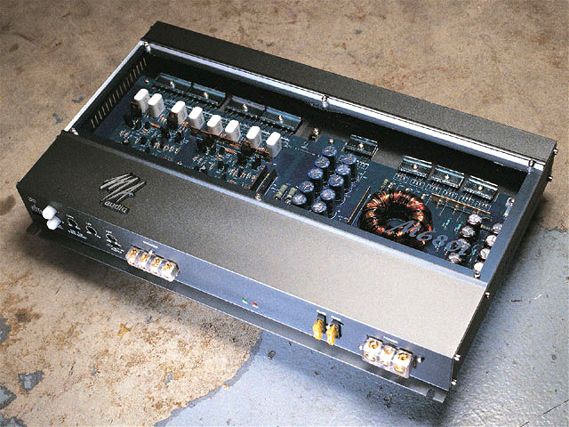 | MA Audio - Exhibitionist
| MA Audio - Exhibitionist
We know MA Audio has good taste in spokeswomen. Do they also have it in amp design? We take a look at the company's M680i (sounds strangely Bavarian...) two-channel offering.
A two-channel amp rated at 200 watts RMS a side (400 watts peak), MA Audio's new M680i features user-selectable high- or low-pass variable crossover, switchable bass boost and speaker level inputs, for those with head units not rigged with RCA outs.
On the BenchWe ran the M680i at 4-ohm stereo in two-channel mode and 4-ohm mono in bridged mode. In two-channel mode, we used the onboard high-pass crossover with our 6.5-in. components. When bridged we used the low-pass linked to various reference subs. We gave it a full one volt of signal input-the maximum it can accept-then added 5dB additional gain overlap to bring the signal level up to 1.74 volts. Following are our measurements playing actual music, not test tones, bass discs, or sine waves (see pg. 81 for a full explanation of our test procedures).
MA Audio does not specify in the manual, nor on the box, the ohm load and supply voltage they used to achieve the 200watts/channel spec. We ran it at four ohms since we feel it's the best indication of an amp's "real-world" performance and its long-term health. In any case, the measured output power versus the minimum measured supply voltage of 13.8v makes this amp 60 percent efficient under full power with maximum rated signal input.
We didn't observe any serious heating problems during testing, but the heatsink does need breathing room below. The top cover employs a clear window that reveals the pretty (really) guts of the machine, but doesn't do much to sweep away heat.
We did test the M680i at 2 ohms, but found the power increase marginal and the heat increase noticeable. To run all day long without trouble, best to keep this amp at four ohms. At idle, with no signal on the input, the M680i drew just 0.62a, about par for a car audio amp of this class.
Crossovers and Set UpThe high-pass crossover is variable between 120-800Hz and the low-pass between 40 and 120Hz. Filter slopes are not mentioned in the manual,but we found the crossover points accurate with the corresponding numbers silk-screened on the amp's side. The slope turned out to be about 12dB/octave. A simple switch selects high-pass, low-pass, or full-range (no crossover) functions.
The high-pass crossover goes down only as low as 120Hz, not a problem in most cases. This can sometimes be a blessing with front speakers unable to handle frequencies below 120. If you've gone great lengths to get good front stage drivers that can handle 80-90Hz or above, another half octave lower on the crossover would have been nice.
The M680i also includes a 50Hz bass boost rated to be 18dB/octave. We measured boost at 50Hz at 14dB/ octave. If you've read our reviews before, you know this is a good thing. If your system lacks good bass, don't look to bass boost for a fix. Rather, build a better subwoofer system.
Installing the M680i is a piece of cake thanks to terminals laid out on only one side of the amp. All that's really necessary is to connect the power and speaker wiring, plug in an RCA audio cable and set crossover filters. Since there are two 20a ATC fuses on board, you'll need to install a fuse of similar value where you connect to the battery. Power and ground terminals accept 8-gauge wire.
Set-up is also pretty simple. The range of input signal is just 100mV-1volt. Even with 5dB of gain overlap, we couldn't hit full volume on our test head unit (2.31 volts) without overloading the input, meaning that head units pushing more than two volts from the RCA outputs will quickly drive the amp to clipping. If you're considering the M680i, make sure to mate it with a head unit pumping LESS than two volts at full volume.
The amp measures 15.8(L) x 9.9(W) x 2.14(H) in. Its size, looks and cooling requirements make it an "open" application amp, meaning you'll want to display it in the trunk or inside the cabin in a visible spot. The owner's manual even breaks down helpful truths about trunk mounting and how hot a trunk can get.
The ManualThe owner's manual covers five different MA amplifiers in this series. It has clear, easily understandable diagrams for each of the terminals on the amplifier and also a clear diagram for each of the control functions (bass boost and crossover). In back are explicit descriptions on how to connect several possible systems. It is, with the exception of one portion, a well-assembled aide.
There is one section, however, that contains misguided information regarding gain settings. Instructions state that you should "never turn up the volume of the head unit more than two-thirds of maximum volume to adjust the level." This is incorrect. If the head unit has clean (unclipped) output up to max volume, this allows the gain position to be set lower. Lower gain makes the signal, rather than the amp, work hard. Less work means less heat.
With just one volt of signal as the maximum input, two-thirds of volume would be a fraction of a volt driving the input, which is a great way to get unwanted noise into a system. Always ask the head unit to do the work of driving signal into an amp, then be sure the amplifier can handle the input voltage.
The MA Audio M680i performs decently for a 100 watt-per-channel amp, produces only moderate heat while driving 4-ohm stereo or bridged loads, and comes with an added cosmetic benefit-the clear top-for show. Paired with an appropriate head unit, it's a package with performance and panache.
